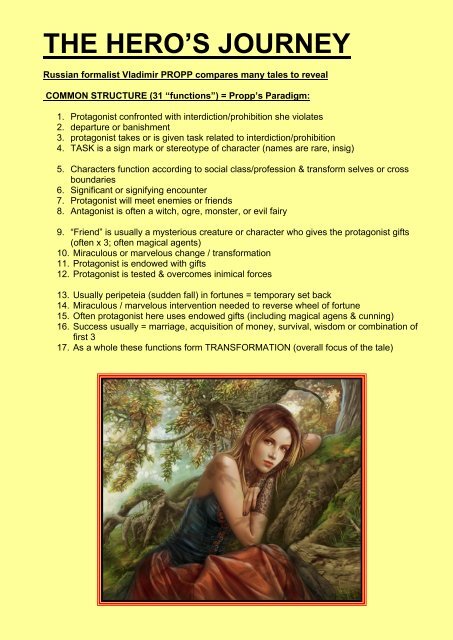HOW TO WRITE BETTER FAIRY TALES - DEAN AMORY
Complete course on writing Fairy Tales (aka Wonder Tales)
Complete course on writing Fairy Tales (aka Wonder Tales)
Create successful ePaper yourself
Turn your PDF publications into a flip-book with our unique Google optimized e-Paper software.
THE HERO’S JOURNEY<br />
Russian formalist Vladimir PROPP compares many tales to reveal<br />
COMMON STRUCTURE (31 “functions”) = Propp’s Paradigm:<br />
1. Protagonist confronted with interdiction/prohibition she violates<br />
2. departure or banishment<br />
3. protagonist takes or is given task related to interdiction/prohibition<br />
4. TASK is a sign mark or stereotype of character (names are rare, insig)<br />
5. Characters function according to social class/profession & transform selves or cross<br />
boundaries<br />
6. Significant or signifying encounter<br />
7. Protagonist will meet enemies or friends<br />
8. Antagonist is often a witch, ogre, monster, or evil fairy<br />
9. “Friend” is usually a mysterious creature or character who gives the protagonist gifts<br />
(often x 3; often magical agents)<br />
10. Miraculous or marvelous change / transformation<br />
11. Protagonist is endowed with gifts<br />
12. Protagonist is tested & overcomes inimical forces<br />
13. Usually peripeteia (sudden fall) in fortunes = temporary set back<br />
14. Miraculous / marvelous intervention needed to reverse wheel of fortune<br />
15. Often protagonist here uses endowed gifts (including magical agens & cunning)<br />
16. Success usually = marriage, acquisition of money, survival, wisdom or combination of<br />
first 3<br />
17. As a whole these functions form TRANSFORMATION (overall focus of the tale)


















